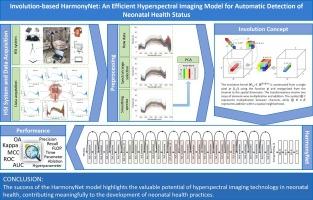基于卷积的和谐网络:用于自动检测新生儿健康状况的高效高光谱成像模型
IF 4.9
2区 医学
Q1 ENGINEERING, BIOMEDICAL
引用次数: 0
摘要
背景和目的新生儿健康对婴儿早期护理至关重要,准确及时的诊断对有效干预至关重要。体格检查和实验室检测等传统方法可能缺乏早期检测所需的精确度。高光谱成像(HSI)可通过多个波长进行非侵入性的详细分析,是一种前景广阔的新生儿诊断工具。本研究介绍了 HarmonyNet,这是一种基于内卷的高光谱成像模型,旨在提高新生儿健康状况分类的准确性和效率。方法在塞尔丘克大学新生儿重症监护室收集了 220 名新生儿的数据,其中包括 110 名健康婴儿和 110 名确诊患有呼吸窘迫综合征(RDS)、气胸(PTX)和主动脉共缩(AORT)等疾病的婴儿。HarmonyNet 模型结合了内卷核和残差块,以加强特征提取。该模型的性能使用总体准确度、精确度、召回率和曲线下面积 (AUC) 等指标进行评估。结果HarmonyNet的AUC达到98.99%,总体准确率、精确率和召回率均为90.91%,优于现有的基于卷积的模型。事实证明,其参数数量少、计算效率高,在数据量少的情况下尤其具有优势。消融研究进一步证明了内卷层和残余区块在提高分类准确性方面的重要性。它的非侵入性有助于改善健康状况,提高医疗干预的效率。未来的研究应侧重于扩大数据集和探索该模型在多类分类任务中的潜力。本文章由计算机程序翻译,如有差异,请以英文原文为准。

Involution-based HarmonyNet: An efficient hyperspectral imaging model for automatic detection of neonatal health status
Background and Objective
Neonatal health is critical for early infant care, where accurate and timely diagnoses are essential for effective intervention. Traditional methods such as physical exams and laboratory tests may lack the precision required for early detection. Hyperspectral imaging (HSI) provides non-invasive, detailed analysis across multiple wavelengths, making it a promising tool for neonatal diagnostics. This study introduces HarmonyNet, an involution-based HSI model designed to improve the accuracy and efficiency of classifying neonatal health conditions.
Methods
Data from 220 neonates were collected at the Neonatal Intensive Care Unit of Selçuk University, comprising 110 healthy infants and 110 diagnosed with conditions such as respiratory distress syndrome (RDS), pneumothorax (PTX), and coarctation of the aorta (AORT). The HarmonyNet model incorporates involution kernels and residual blocks to enhance feature extraction. The model’s performance was evaluated using metrics such as overall accuracy, precision, recall, and area under the curve (AUC). Ablation studies were conducted to optimize hyperparameters and network architecture.
Results
HarmonyNet achieved an AUC of 98.99%, with overall accuracy, precision and recall rates of 90.91%, outperforming existing convolution-based models. Its low parameter count and computational efficiency proved particularly advantageous in low-data scenarios. Ablation studies further demonstrated the importance of involution layers and residual blocks in improving classification accuracy.
Conclusions
HarmonyNet represents a significant advancement in neonatal diagnostics, offering high accuracy with computational efficiency. Its non-invasive nature can contribute to improved health outcomes and more efficient medical interventions. Future research should focus on expanding the dataset and exploring the model’s potential in multi-class classification tasks.
求助全文
通过发布文献求助,成功后即可免费获取论文全文。
去求助
来源期刊

Biomedical Signal Processing and Control
工程技术-工程:生物医学
CiteScore
9.80
自引率
13.70%
发文量
822
审稿时长
4 months
期刊介绍:
Biomedical Signal Processing and Control aims to provide a cross-disciplinary international forum for the interchange of information on research in the measurement and analysis of signals and images in clinical medicine and the biological sciences. Emphasis is placed on contributions dealing with the practical, applications-led research on the use of methods and devices in clinical diagnosis, patient monitoring and management.
Biomedical Signal Processing and Control reflects the main areas in which these methods are being used and developed at the interface of both engineering and clinical science. The scope of the journal is defined to include relevant review papers, technical notes, short communications and letters. Tutorial papers and special issues will also be published.
 求助内容:
求助内容: 应助结果提醒方式:
应助结果提醒方式:


